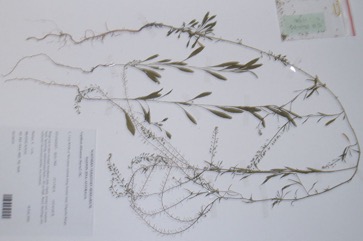Common peppercress, Pepperweed

It is a subtropical plant. It grows in hot arid areas that have a marked dry season. The dry season can be 6-11 months. It needs well-drained soils and grow in stony and sandy soils. It grows between 400-1,700 m above sea level. It can grow in arid places. It will grow in most freely draining soils. It can grow in sunny or lightly shaded locations. Tasmania Herbarium.
Also known as:
Dittander, Pepper grass, Pepperwort, Peppercress, Soft peppercress
Synonyms
- Lepidium africanum subsp. africanum DC.
- Lepidium africanum subsp. divaricatum (Aiton) Jonsell
- Lepidium ambiguum F. Muell.
- Lepidium capense
- ? Lepidium divaricatum Aiton
- Lepidium dubium Thell.
- Lepidium hyssopifolium Desv.
- Lepidium schlechteri Thell.
- Lepidium tasmanicum Thell. Nasturtium divaricatum (Aiton) Kuntze
- Thlapsi africanum Burm.f.
- Thlaspi divaricatum (Aiton) Poir.
Edible Portion
- Leaves
Where does Common peppercress grow?
Found in: Africa, Australia, East Africa, Eswatini, Hawaii, Lord Howe Island, Mozambique, Namibia, Pacific, South Africa, Southern Africa, St Helena, Swaziland, Tasmania
Notes: There are about 180 Lepidium species.
Growing Common peppercress, Pepperweed
Edible Uses: The leaves are eaten as a spinach. The green seed is used as a spice.
Nutrition Info
per 100g edible portion| Edible Part | Energy (kcal) | Protein (g) | Iron (mg) | Vitamin A (ug) | Vitamin c (mg) | Zinc (mg) | % Water |
|---|---|---|---|---|---|---|---|
| - | - | - | - | - | - |
Common peppercress, Pepperweed Photos

References
Cribb, A.B. & J.W., 1976, Wild Food in Australia, Fontana. p 123 (As Lepidium hyssopifolium)
Dashorst, G.R.M., and Jessop, J.P., 1998, Plants of the Adelaide Plains & Hills. Botanic Gardens of Adelaide and State Herbarium. p 68
Elliot, W.R., & Jones, D.L., 1993, Encyclopedia of Australian Plants suitable for cultivation. Vol 6. Lothian. p 84 (As Lepidium hyssopifolium)
Flora of Australia, Volume 8, Lecythidales to Batales, Australian Government Publishing Service, Canberra (1982) p 275, p 278 (As Lepidium hyssopifolium)
Flora of Australia Volume 49, Oceanic Islands 1, Australian Government Publishing Service, Canberra. (1994) p 139
Harris, S., Buchanan, A., Connolly, A., 2001, One Hundred Islands: The Flora of the Outer Furneaux. Tas Govt. p 176 (As Lepidium hyssopifolium)
Hussey, B.M.J., Keighery, G.J., Cousens, R.D., Dodd, J., Lloyd, S.G., 1997, Western Weeds. A guide to the weeds of Western Australia. Plant Protection Society of Western Australia. p 118
Jardin, C., 1970, List of Foods Used In Africa, FAO Nutrition Information Document Series No 2.p 86
Lazarides, M. & Hince, B., 1993, Handbook of Economic Plants of Australia, CSIRO. p 146
Long, C., 2005, Swaziland's Flora - siSwati names and Uses http://www.sntc.org.sz/flora/
Low, T., 1991, Wild Herbs of Australia and New Zealand. Angus & Robertson. p 56 (Drawing)
Martin, F.W. & Ruberte, R.M., 1979, Edible Leaves of the Tropics. Antillian College Press, Mayaguez, Puerto Rico. p 188
Paczkowska, G. & Chapman, A.R., 2000, The Western Australian Flora. A Descriptive Catalogue. Western Australian Herbarium. p 186
Plants for a Future database, The Field, Penpol, Lostwithiel, Cornwall, PL22 0NG, UK. http://www.scs.leeds.ac.uk/pfaf/ (As Lepidium hyssopifolium)
Royal Botanic Gardens, Kew (1999). Survey of Economic Plants for Arid and Semi-Arid Lands (SEPASAL) database. Published on the Internet; http://www.rbgkew.org.uk/ceb/sepasal/internet [Accessed 15th April 2011] (As Lepidium africanum subsp. divaricatum)
Ruiters-Welcome, A. K., 2019, Food plants of southern Africa. Ph.D. thesis. Univ. of Johannesburg p 39
Seidemann J., 2005, World Spice Plants. Economic Usage, Botany, Taxonomy. Springer. p 201 (As Lepidium africanum subsp. divaricatum)
Swaziland's Flora Database http://www.sntc.org.sz/flora
Tasmanian Herbarium Vascular Plants list p 17 (As Lepidium hyssopifolium)
Terra, G.J.A., 1973, Tropical Vegetables. Communication 54e Royal Tropical Institute, Amsterdam, p 56
Whiting, J. et al, 2004, Tasmania's Natural Flora. Tasmania's Natural Flora Editorial Committee PO Box 194, Ulverstone, Tasmania, Australia 7315 p 80 (As Lepidium hyssopifolium)
World Checklist of Useful Plant Species 2020. Royal Botanic Gardens, Kew